Management Accounting Report: Qantas Airlines Executive Remuneration
VerifiedAdded on 2021/06/16
|23
|5870
|22
Report
AI Summary
This report provides an evaluation of the remuneration report of Qantas Airlines, a company listed on the Australian Stock Exchange. The analysis compares the company's practices with existing literature on performance measures and performance pay. The report examines the alignment of Qantas' remuneration with its organizational performance, incentive plans, and shareholder value, presenting four different viewpoints based on the company's annual report. Key aspects considered include shareholder involvement, financial and non-financial measures, company performance, and executive pay. The report summarizes the findings and offers recommendations for broadening performance measures. Additionally, the report notes the absence of deferred tax liabilities in the current year's balance sheet. The study aims to determine the effectiveness of Qantas' control systems by examining its reward systems and executive performance.
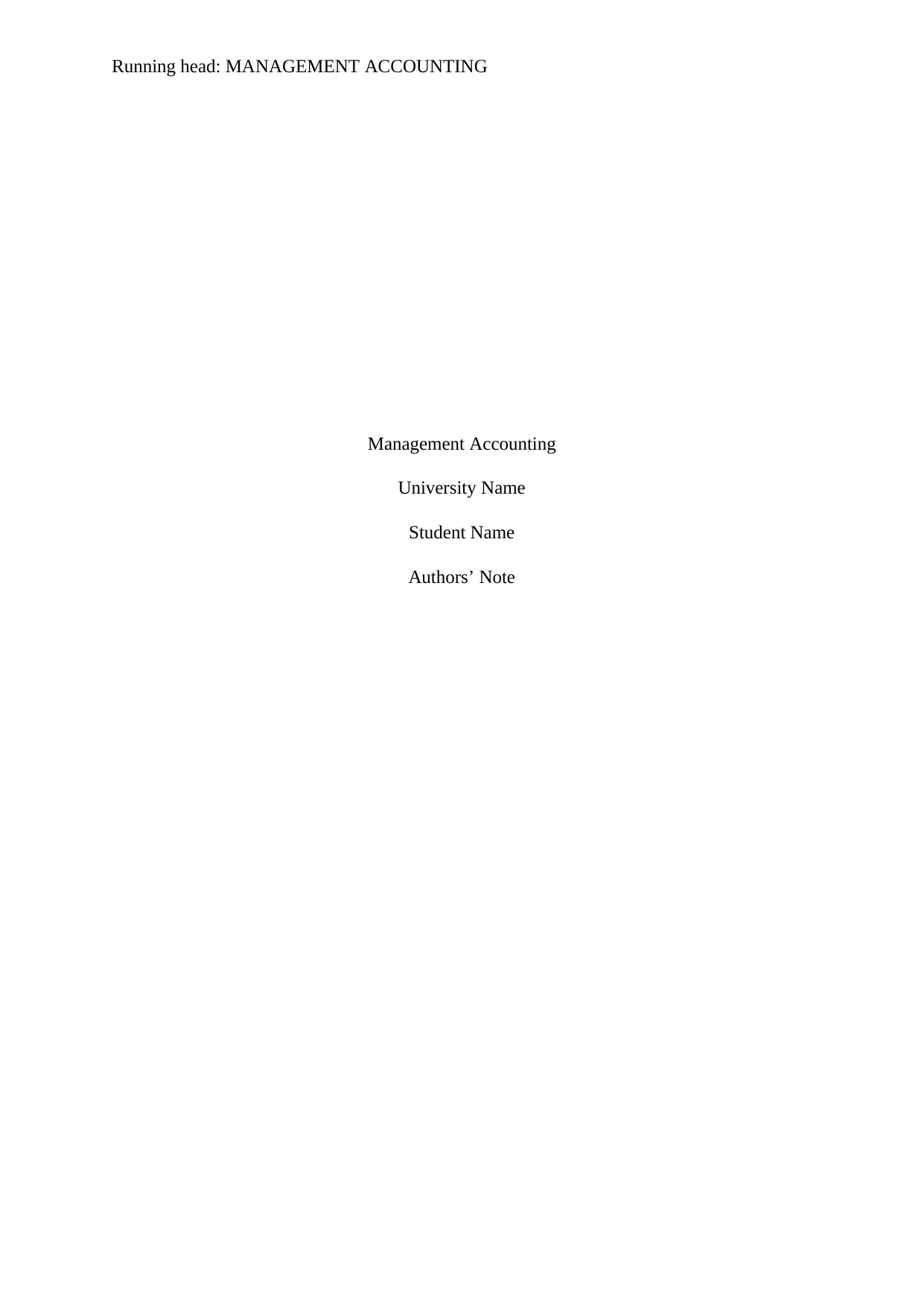
Running head: MANAGEMENT ACCOUNTING
Management Accounting
University Name
Student Name
Authors’ Note
Management Accounting
University Name
Student Name
Authors’ Note
Paraphrase This Document
Need a fresh take? Get an instant paraphrase of this document with our AI Paraphraser
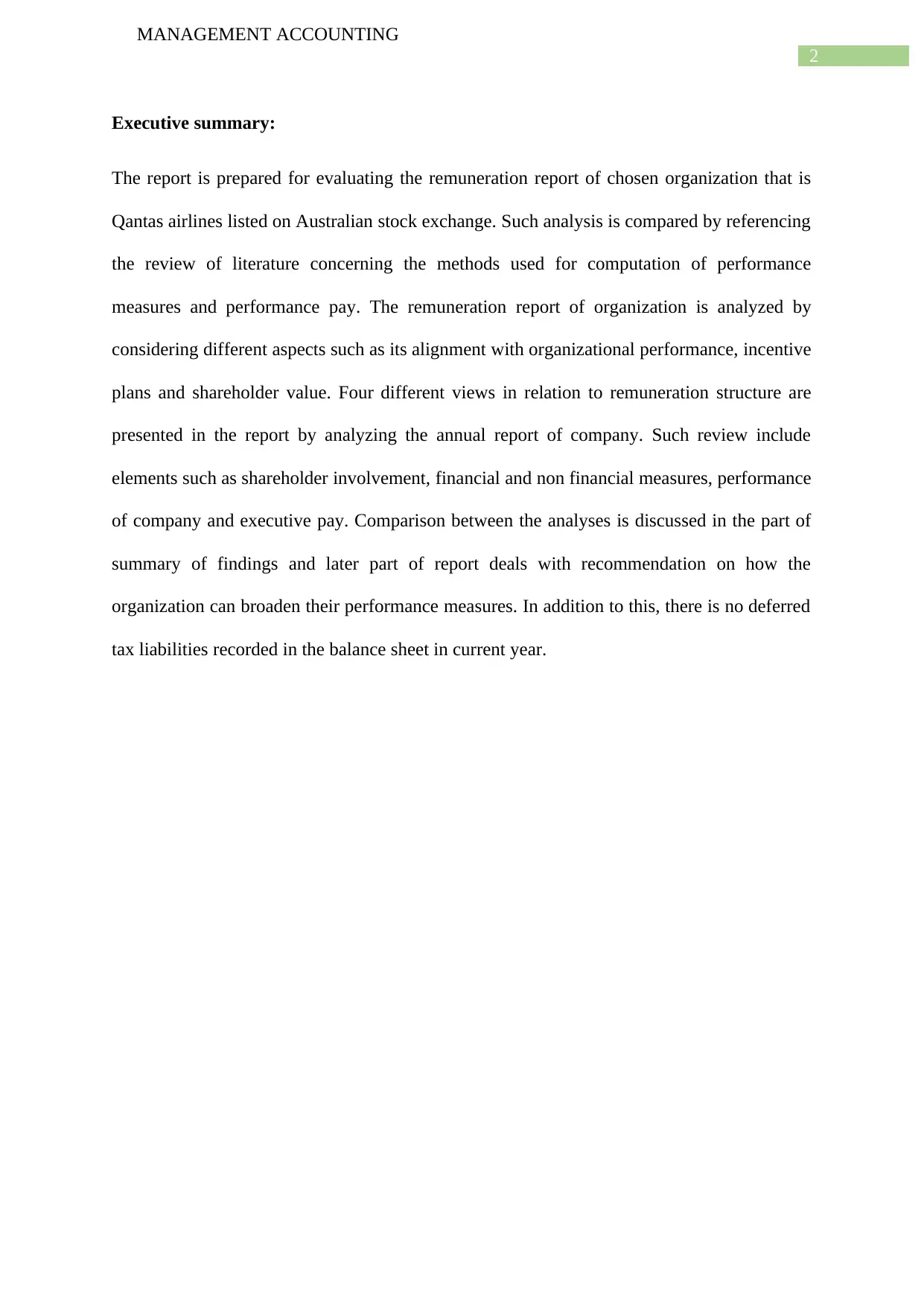
2
MANAGEMENT ACCOUNTING
Executive summary:
The report is prepared for evaluating the remuneration report of chosen organization that is
Qantas airlines listed on Australian stock exchange. Such analysis is compared by referencing
the review of literature concerning the methods used for computation of performance
measures and performance pay. The remuneration report of organization is analyzed by
considering different aspects such as its alignment with organizational performance, incentive
plans and shareholder value. Four different views in relation to remuneration structure are
presented in the report by analyzing the annual report of company. Such review include
elements such as shareholder involvement, financial and non financial measures, performance
of company and executive pay. Comparison between the analyses is discussed in the part of
summary of findings and later part of report deals with recommendation on how the
organization can broaden their performance measures. In addition to this, there is no deferred
tax liabilities recorded in the balance sheet in current year.
MANAGEMENT ACCOUNTING
Executive summary:
The report is prepared for evaluating the remuneration report of chosen organization that is
Qantas airlines listed on Australian stock exchange. Such analysis is compared by referencing
the review of literature concerning the methods used for computation of performance
measures and performance pay. The remuneration report of organization is analyzed by
considering different aspects such as its alignment with organizational performance, incentive
plans and shareholder value. Four different views in relation to remuneration structure are
presented in the report by analyzing the annual report of company. Such review include
elements such as shareholder involvement, financial and non financial measures, performance
of company and executive pay. Comparison between the analyses is discussed in the part of
summary of findings and later part of report deals with recommendation on how the
organization can broaden their performance measures. In addition to this, there is no deferred
tax liabilities recorded in the balance sheet in current year.
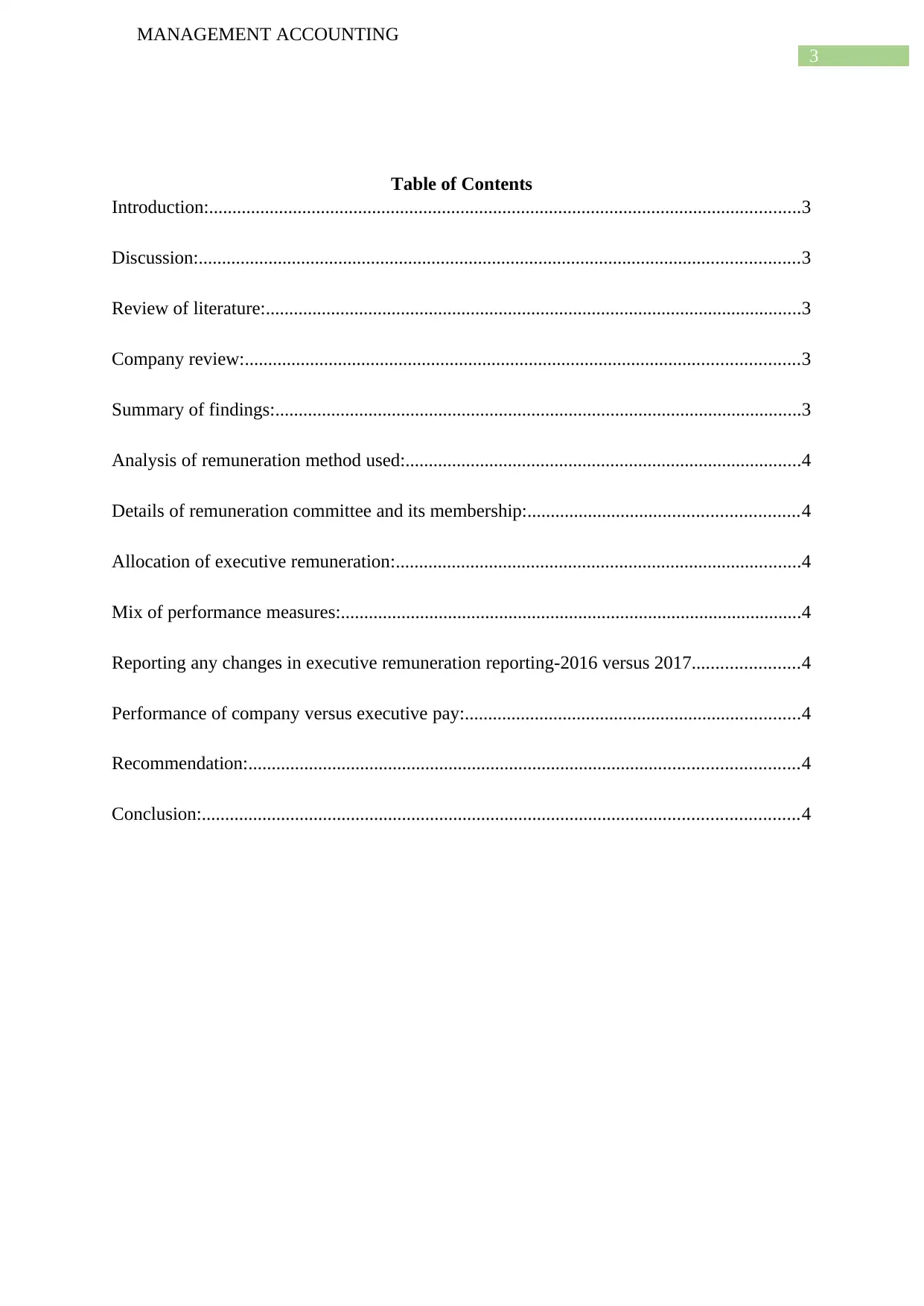
3
MANAGEMENT ACCOUNTING
Table of Contents
Introduction:...............................................................................................................................3
Discussion:.................................................................................................................................3
Review of literature:...................................................................................................................3
Company review:.......................................................................................................................3
Summary of findings:.................................................................................................................3
Analysis of remuneration method used:.....................................................................................4
Details of remuneration committee and its membership:..........................................................4
Allocation of executive remuneration:.......................................................................................4
Mix of performance measures:...................................................................................................4
Reporting any changes in executive remuneration reporting-2016 versus 2017.......................4
Performance of company versus executive pay:........................................................................4
Recommendation:......................................................................................................................4
Conclusion:................................................................................................................................4
MANAGEMENT ACCOUNTING
Table of Contents
Introduction:...............................................................................................................................3
Discussion:.................................................................................................................................3
Review of literature:...................................................................................................................3
Company review:.......................................................................................................................3
Summary of findings:.................................................................................................................3
Analysis of remuneration method used:.....................................................................................4
Details of remuneration committee and its membership:..........................................................4
Allocation of executive remuneration:.......................................................................................4
Mix of performance measures:...................................................................................................4
Reporting any changes in executive remuneration reporting-2016 versus 2017.......................4
Performance of company versus executive pay:........................................................................4
Recommendation:......................................................................................................................4
Conclusion:................................................................................................................................4
⊘ This is a preview!⊘
Do you want full access?
Subscribe today to unlock all pages.

Trusted by 1+ million students worldwide
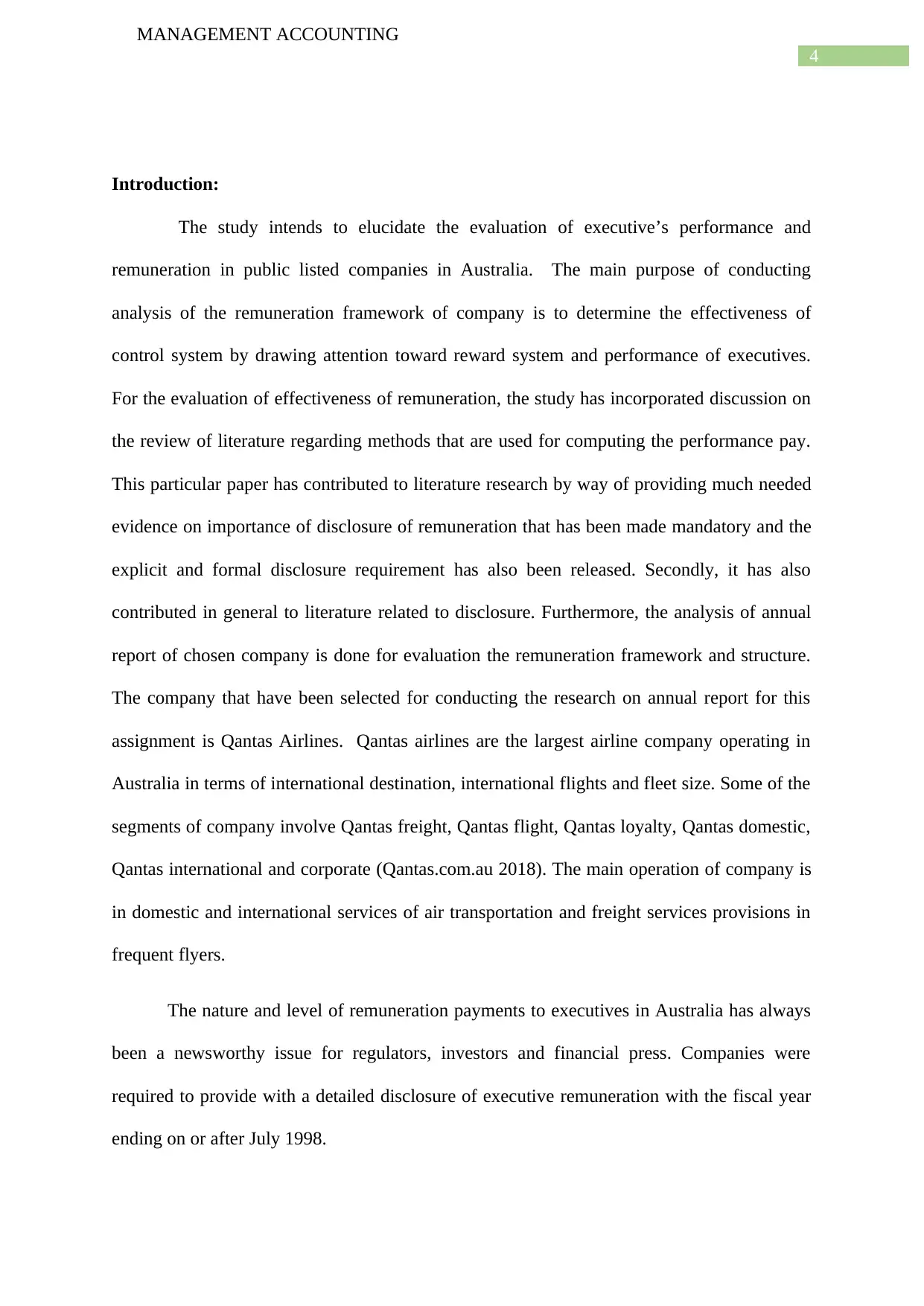
4
MANAGEMENT ACCOUNTING
Introduction:
The study intends to elucidate the evaluation of executive’s performance and
remuneration in public listed companies in Australia. The main purpose of conducting
analysis of the remuneration framework of company is to determine the effectiveness of
control system by drawing attention toward reward system and performance of executives.
For the evaluation of effectiveness of remuneration, the study has incorporated discussion on
the review of literature regarding methods that are used for computing the performance pay.
This particular paper has contributed to literature research by way of providing much needed
evidence on importance of disclosure of remuneration that has been made mandatory and the
explicit and formal disclosure requirement has also been released. Secondly, it has also
contributed in general to literature related to disclosure. Furthermore, the analysis of annual
report of chosen company is done for evaluation the remuneration framework and structure.
The company that have been selected for conducting the research on annual report for this
assignment is Qantas Airlines. Qantas airlines are the largest airline company operating in
Australia in terms of international destination, international flights and fleet size. Some of the
segments of company involve Qantas freight, Qantas flight, Qantas loyalty, Qantas domestic,
Qantas international and corporate (Qantas.com.au 2018). The main operation of company is
in domestic and international services of air transportation and freight services provisions in
frequent flyers.
The nature and level of remuneration payments to executives in Australia has always
been a newsworthy issue for regulators, investors and financial press. Companies were
required to provide with a detailed disclosure of executive remuneration with the fiscal year
ending on or after July 1998.
MANAGEMENT ACCOUNTING
Introduction:
The study intends to elucidate the evaluation of executive’s performance and
remuneration in public listed companies in Australia. The main purpose of conducting
analysis of the remuneration framework of company is to determine the effectiveness of
control system by drawing attention toward reward system and performance of executives.
For the evaluation of effectiveness of remuneration, the study has incorporated discussion on
the review of literature regarding methods that are used for computing the performance pay.
This particular paper has contributed to literature research by way of providing much needed
evidence on importance of disclosure of remuneration that has been made mandatory and the
explicit and formal disclosure requirement has also been released. Secondly, it has also
contributed in general to literature related to disclosure. Furthermore, the analysis of annual
report of chosen company is done for evaluation the remuneration framework and structure.
The company that have been selected for conducting the research on annual report for this
assignment is Qantas Airlines. Qantas airlines are the largest airline company operating in
Australia in terms of international destination, international flights and fleet size. Some of the
segments of company involve Qantas freight, Qantas flight, Qantas loyalty, Qantas domestic,
Qantas international and corporate (Qantas.com.au 2018). The main operation of company is
in domestic and international services of air transportation and freight services provisions in
frequent flyers.
The nature and level of remuneration payments to executives in Australia has always
been a newsworthy issue for regulators, investors and financial press. Companies were
required to provide with a detailed disclosure of executive remuneration with the fiscal year
ending on or after July 1998.
Paraphrase This Document
Need a fresh take? Get an instant paraphrase of this document with our AI Paraphraser
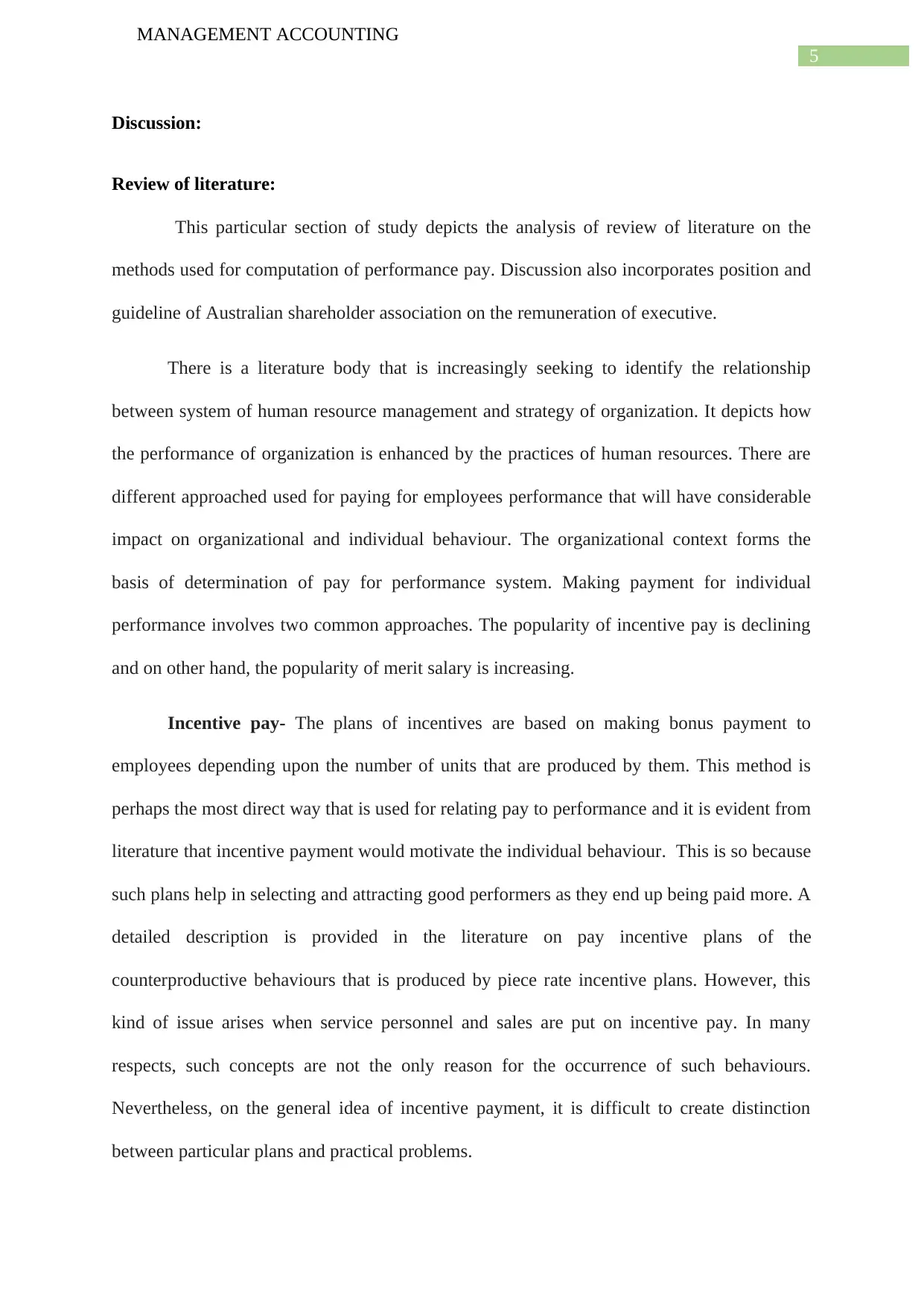
5
MANAGEMENT ACCOUNTING
Discussion:
Review of literature:
This particular section of study depicts the analysis of review of literature on the
methods used for computation of performance pay. Discussion also incorporates position and
guideline of Australian shareholder association on the remuneration of executive.
There is a literature body that is increasingly seeking to identify the relationship
between system of human resource management and strategy of organization. It depicts how
the performance of organization is enhanced by the practices of human resources. There are
different approached used for paying for employees performance that will have considerable
impact on organizational and individual behaviour. The organizational context forms the
basis of determination of pay for performance system. Making payment for individual
performance involves two common approaches. The popularity of incentive pay is declining
and on other hand, the popularity of merit salary is increasing.
Incentive pay- The plans of incentives are based on making bonus payment to
employees depending upon the number of units that are produced by them. This method is
perhaps the most direct way that is used for relating pay to performance and it is evident from
literature that incentive payment would motivate the individual behaviour. This is so because
such plans help in selecting and attracting good performers as they end up being paid more. A
detailed description is provided in the literature on pay incentive plans of the
counterproductive behaviours that is produced by piece rate incentive plans. However, this
kind of issue arises when service personnel and sales are put on incentive pay. In many
respects, such concepts are not the only reason for the occurrence of such behaviours.
Nevertheless, on the general idea of incentive payment, it is difficult to create distinction
between particular plans and practical problems.
MANAGEMENT ACCOUNTING
Discussion:
Review of literature:
This particular section of study depicts the analysis of review of literature on the
methods used for computation of performance pay. Discussion also incorporates position and
guideline of Australian shareholder association on the remuneration of executive.
There is a literature body that is increasingly seeking to identify the relationship
between system of human resource management and strategy of organization. It depicts how
the performance of organization is enhanced by the practices of human resources. There are
different approached used for paying for employees performance that will have considerable
impact on organizational and individual behaviour. The organizational context forms the
basis of determination of pay for performance system. Making payment for individual
performance involves two common approaches. The popularity of incentive pay is declining
and on other hand, the popularity of merit salary is increasing.
Incentive pay- The plans of incentives are based on making bonus payment to
employees depending upon the number of units that are produced by them. This method is
perhaps the most direct way that is used for relating pay to performance and it is evident from
literature that incentive payment would motivate the individual behaviour. This is so because
such plans help in selecting and attracting good performers as they end up being paid more. A
detailed description is provided in the literature on pay incentive plans of the
counterproductive behaviours that is produced by piece rate incentive plans. However, this
kind of issue arises when service personnel and sales are put on incentive pay. In many
respects, such concepts are not the only reason for the occurrence of such behaviours.
Nevertheless, on the general idea of incentive payment, it is difficult to create distinction
between particular plans and practical problems.
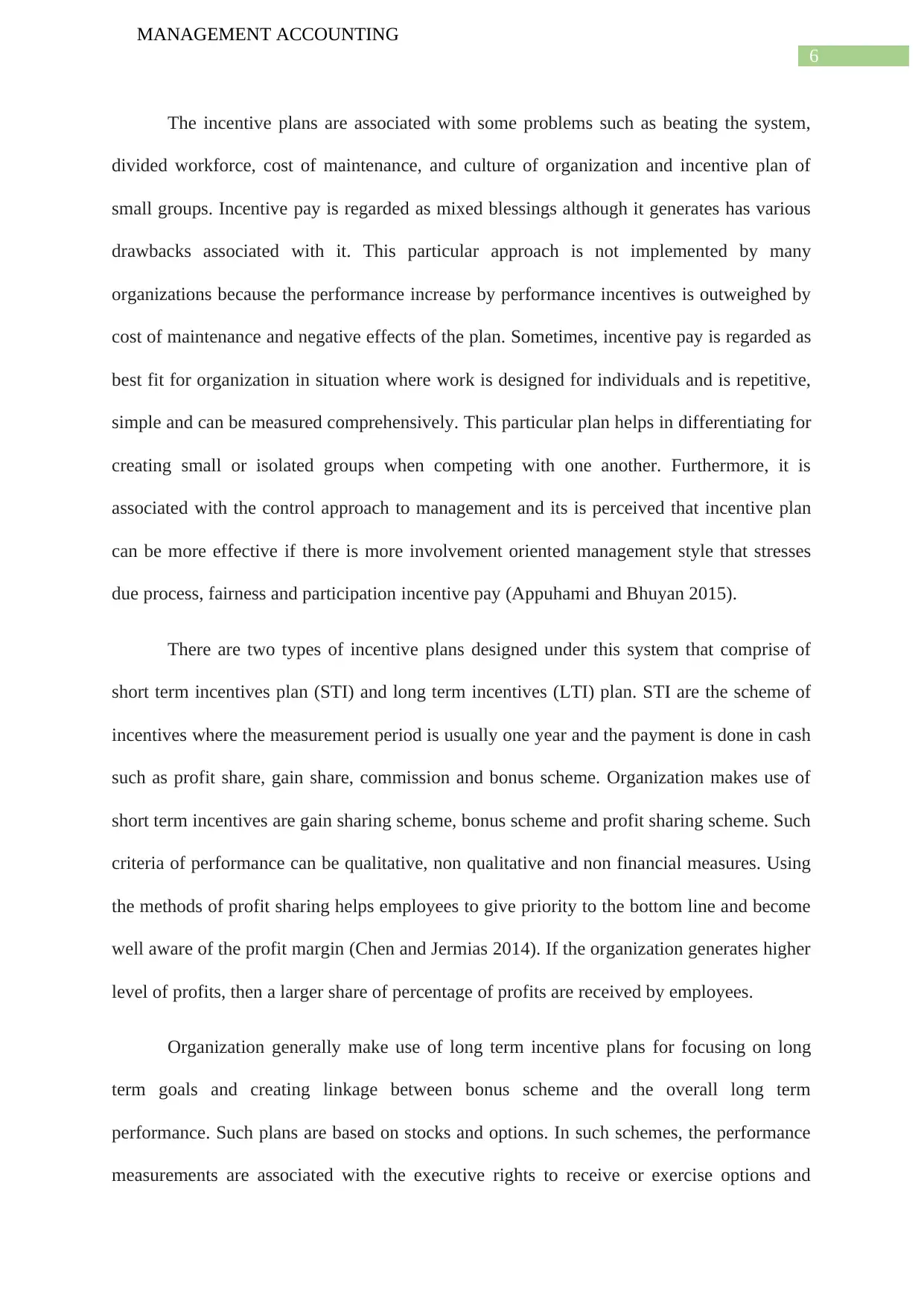
6
MANAGEMENT ACCOUNTING
The incentive plans are associated with some problems such as beating the system,
divided workforce, cost of maintenance, and culture of organization and incentive plan of
small groups. Incentive pay is regarded as mixed blessings although it generates has various
drawbacks associated with it. This particular approach is not implemented by many
organizations because the performance increase by performance incentives is outweighed by
cost of maintenance and negative effects of the plan. Sometimes, incentive pay is regarded as
best fit for organization in situation where work is designed for individuals and is repetitive,
simple and can be measured comprehensively. This particular plan helps in differentiating for
creating small or isolated groups when competing with one another. Furthermore, it is
associated with the control approach to management and its is perceived that incentive plan
can be more effective if there is more involvement oriented management style that stresses
due process, fairness and participation incentive pay (Appuhami and Bhuyan 2015).
There are two types of incentive plans designed under this system that comprise of
short term incentives plan (STI) and long term incentives (LTI) plan. STI are the scheme of
incentives where the measurement period is usually one year and the payment is done in cash
such as profit share, gain share, commission and bonus scheme. Organization makes use of
short term incentives are gain sharing scheme, bonus scheme and profit sharing scheme. Such
criteria of performance can be qualitative, non qualitative and non financial measures. Using
the methods of profit sharing helps employees to give priority to the bottom line and become
well aware of the profit margin (Chen and Jermias 2014). If the organization generates higher
level of profits, then a larger share of percentage of profits are received by employees.
Organization generally make use of long term incentive plans for focusing on long
term goals and creating linkage between bonus scheme and the overall long term
performance. Such plans are based on stocks and options. In such schemes, the performance
measurements are associated with the executive rights to receive or exercise options and
MANAGEMENT ACCOUNTING
The incentive plans are associated with some problems such as beating the system,
divided workforce, cost of maintenance, and culture of organization and incentive plan of
small groups. Incentive pay is regarded as mixed blessings although it generates has various
drawbacks associated with it. This particular approach is not implemented by many
organizations because the performance increase by performance incentives is outweighed by
cost of maintenance and negative effects of the plan. Sometimes, incentive pay is regarded as
best fit for organization in situation where work is designed for individuals and is repetitive,
simple and can be measured comprehensively. This particular plan helps in differentiating for
creating small or isolated groups when competing with one another. Furthermore, it is
associated with the control approach to management and its is perceived that incentive plan
can be more effective if there is more involvement oriented management style that stresses
due process, fairness and participation incentive pay (Appuhami and Bhuyan 2015).
There are two types of incentive plans designed under this system that comprise of
short term incentives plan (STI) and long term incentives (LTI) plan. STI are the scheme of
incentives where the measurement period is usually one year and the payment is done in cash
such as profit share, gain share, commission and bonus scheme. Organization makes use of
short term incentives are gain sharing scheme, bonus scheme and profit sharing scheme. Such
criteria of performance can be qualitative, non qualitative and non financial measures. Using
the methods of profit sharing helps employees to give priority to the bottom line and become
well aware of the profit margin (Chen and Jermias 2014). If the organization generates higher
level of profits, then a larger share of percentage of profits are received by employees.
Organization generally make use of long term incentive plans for focusing on long
term goals and creating linkage between bonus scheme and the overall long term
performance. Such plans are based on stocks and options. In such schemes, the performance
measurements are associated with the executive rights to receive or exercise options and
⊘ This is a preview!⊘
Do you want full access?
Subscribe today to unlock all pages.

Trusted by 1+ million students worldwide
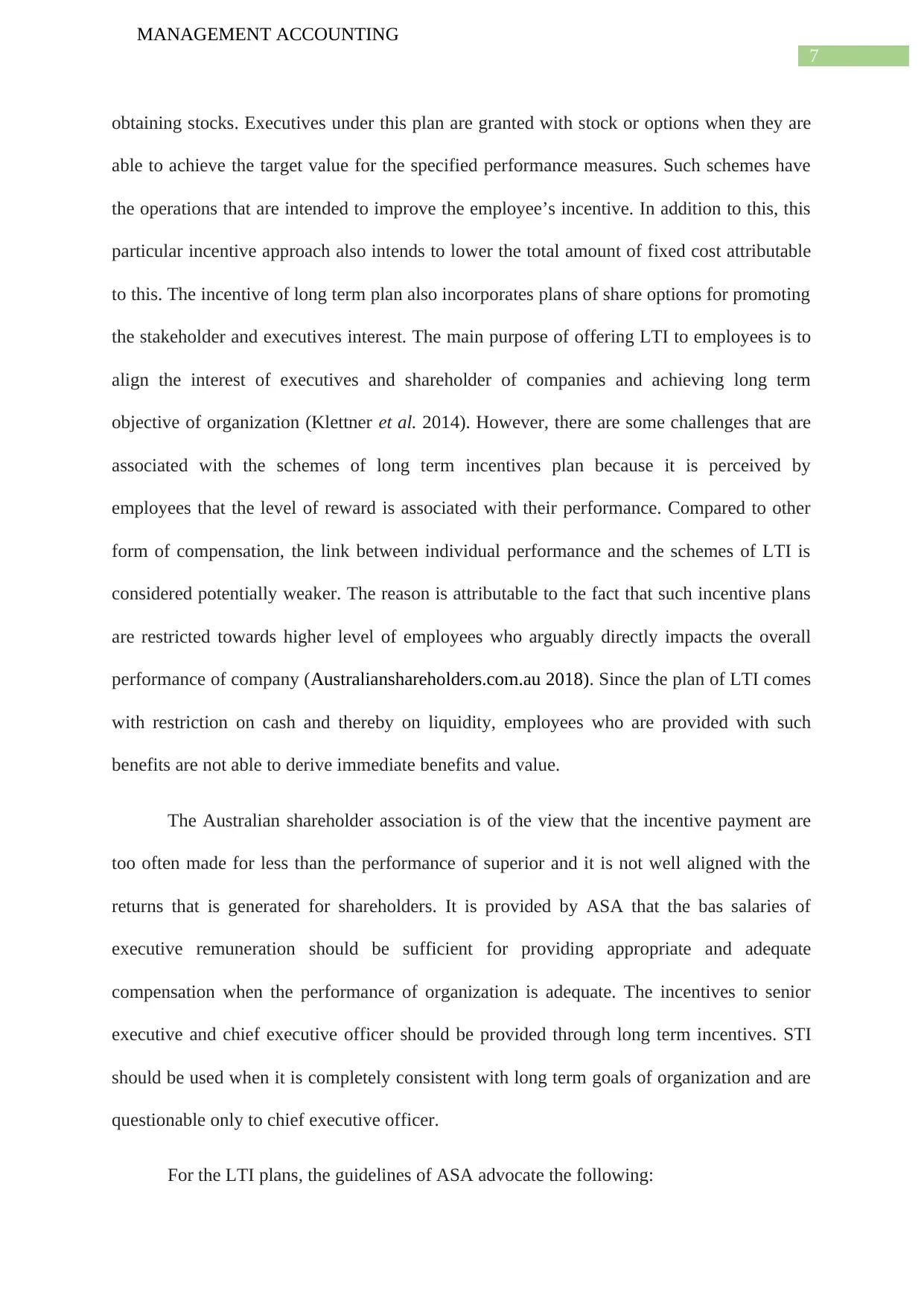
7
MANAGEMENT ACCOUNTING
obtaining stocks. Executives under this plan are granted with stock or options when they are
able to achieve the target value for the specified performance measures. Such schemes have
the operations that are intended to improve the employee’s incentive. In addition to this, this
particular incentive approach also intends to lower the total amount of fixed cost attributable
to this. The incentive of long term plan also incorporates plans of share options for promoting
the stakeholder and executives interest. The main purpose of offering LTI to employees is to
align the interest of executives and shareholder of companies and achieving long term
objective of organization (Klettner et al. 2014). However, there are some challenges that are
associated with the schemes of long term incentives plan because it is perceived by
employees that the level of reward is associated with their performance. Compared to other
form of compensation, the link between individual performance and the schemes of LTI is
considered potentially weaker. The reason is attributable to the fact that such incentive plans
are restricted towards higher level of employees who arguably directly impacts the overall
performance of company (Australianshareholders.com.au 2018). Since the plan of LTI comes
with restriction on cash and thereby on liquidity, employees who are provided with such
benefits are not able to derive immediate benefits and value.
The Australian shareholder association is of the view that the incentive payment are
too often made for less than the performance of superior and it is not well aligned with the
returns that is generated for shareholders. It is provided by ASA that the bas salaries of
executive remuneration should be sufficient for providing appropriate and adequate
compensation when the performance of organization is adequate. The incentives to senior
executive and chief executive officer should be provided through long term incentives. STI
should be used when it is completely consistent with long term goals of organization and are
questionable only to chief executive officer.
For the LTI plans, the guidelines of ASA advocate the following:
MANAGEMENT ACCOUNTING
obtaining stocks. Executives under this plan are granted with stock or options when they are
able to achieve the target value for the specified performance measures. Such schemes have
the operations that are intended to improve the employee’s incentive. In addition to this, this
particular incentive approach also intends to lower the total amount of fixed cost attributable
to this. The incentive of long term plan also incorporates plans of share options for promoting
the stakeholder and executives interest. The main purpose of offering LTI to employees is to
align the interest of executives and shareholder of companies and achieving long term
objective of organization (Klettner et al. 2014). However, there are some challenges that are
associated with the schemes of long term incentives plan because it is perceived by
employees that the level of reward is associated with their performance. Compared to other
form of compensation, the link between individual performance and the schemes of LTI is
considered potentially weaker. The reason is attributable to the fact that such incentive plans
are restricted towards higher level of employees who arguably directly impacts the overall
performance of company (Australianshareholders.com.au 2018). Since the plan of LTI comes
with restriction on cash and thereby on liquidity, employees who are provided with such
benefits are not able to derive immediate benefits and value.
The Australian shareholder association is of the view that the incentive payment are
too often made for less than the performance of superior and it is not well aligned with the
returns that is generated for shareholders. It is provided by ASA that the bas salaries of
executive remuneration should be sufficient for providing appropriate and adequate
compensation when the performance of organization is adequate. The incentives to senior
executive and chief executive officer should be provided through long term incentives. STI
should be used when it is completely consistent with long term goals of organization and are
questionable only to chief executive officer.
For the LTI plans, the guidelines of ASA advocate the following:
Paraphrase This Document
Need a fresh take? Get an instant paraphrase of this document with our AI Paraphraser
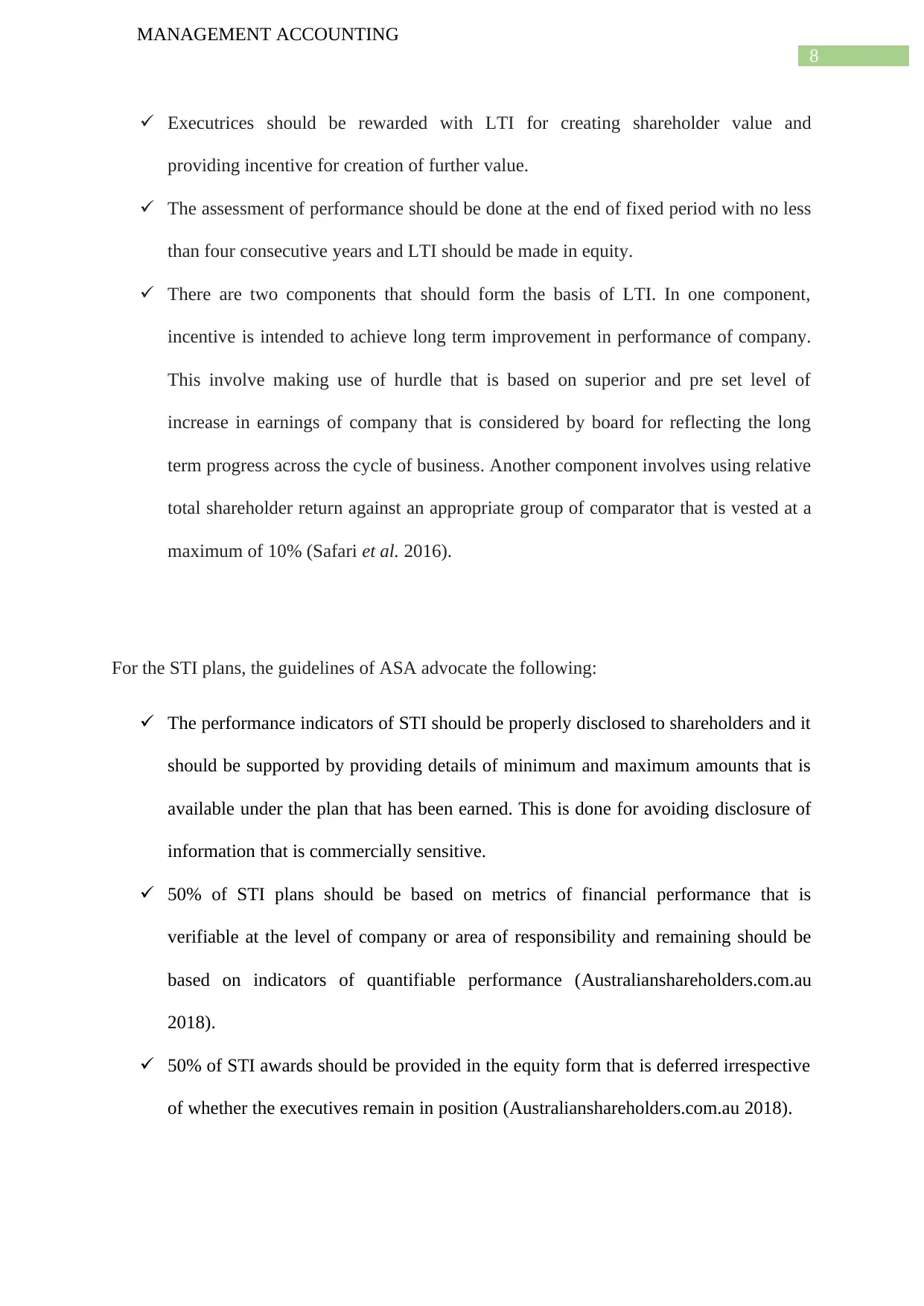
8
MANAGEMENT ACCOUNTING
Executrices should be rewarded with LTI for creating shareholder value and
providing incentive for creation of further value.
The assessment of performance should be done at the end of fixed period with no less
than four consecutive years and LTI should be made in equity.
There are two components that should form the basis of LTI. In one component,
incentive is intended to achieve long term improvement in performance of company.
This involve making use of hurdle that is based on superior and pre set level of
increase in earnings of company that is considered by board for reflecting the long
term progress across the cycle of business. Another component involves using relative
total shareholder return against an appropriate group of comparator that is vested at a
maximum of 10% (Safari et al. 2016).
For the STI plans, the guidelines of ASA advocate the following:
The performance indicators of STI should be properly disclosed to shareholders and it
should be supported by providing details of minimum and maximum amounts that is
available under the plan that has been earned. This is done for avoiding disclosure of
information that is commercially sensitive.
50% of STI plans should be based on metrics of financial performance that is
verifiable at the level of company or area of responsibility and remaining should be
based on indicators of quantifiable performance (Australianshareholders.com.au
2018).
50% of STI awards should be provided in the equity form that is deferred irrespective
of whether the executives remain in position (Australianshareholders.com.au 2018).
MANAGEMENT ACCOUNTING
Executrices should be rewarded with LTI for creating shareholder value and
providing incentive for creation of further value.
The assessment of performance should be done at the end of fixed period with no less
than four consecutive years and LTI should be made in equity.
There are two components that should form the basis of LTI. In one component,
incentive is intended to achieve long term improvement in performance of company.
This involve making use of hurdle that is based on superior and pre set level of
increase in earnings of company that is considered by board for reflecting the long
term progress across the cycle of business. Another component involves using relative
total shareholder return against an appropriate group of comparator that is vested at a
maximum of 10% (Safari et al. 2016).
For the STI plans, the guidelines of ASA advocate the following:
The performance indicators of STI should be properly disclosed to shareholders and it
should be supported by providing details of minimum and maximum amounts that is
available under the plan that has been earned. This is done for avoiding disclosure of
information that is commercially sensitive.
50% of STI plans should be based on metrics of financial performance that is
verifiable at the level of company or area of responsibility and remaining should be
based on indicators of quantifiable performance (Australianshareholders.com.au
2018).
50% of STI awards should be provided in the equity form that is deferred irrespective
of whether the executives remain in position (Australianshareholders.com.au 2018).
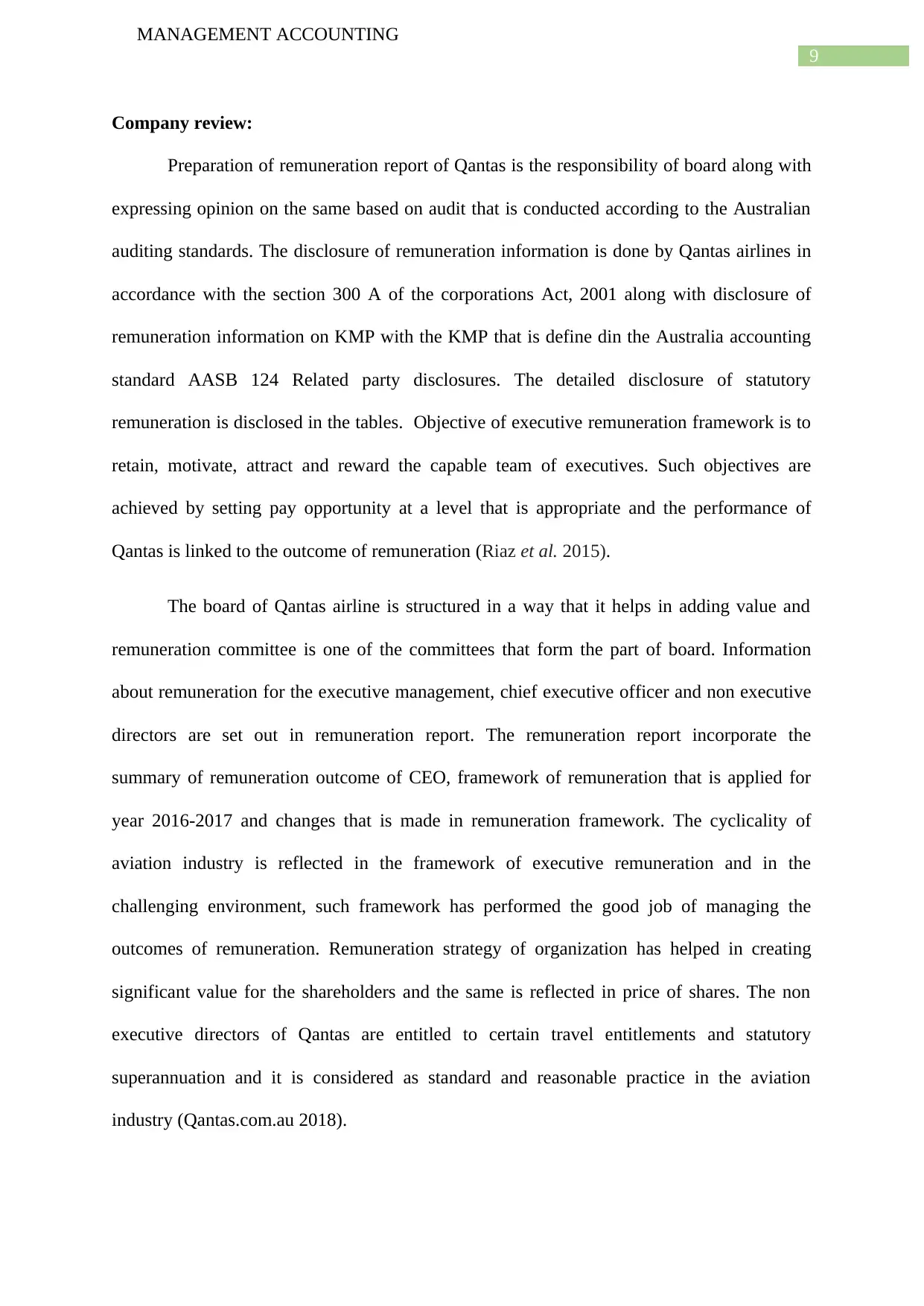
9
MANAGEMENT ACCOUNTING
Company review:
Preparation of remuneration report of Qantas is the responsibility of board along with
expressing opinion on the same based on audit that is conducted according to the Australian
auditing standards. The disclosure of remuneration information is done by Qantas airlines in
accordance with the section 300 A of the corporations Act, 2001 along with disclosure of
remuneration information on KMP with the KMP that is define din the Australia accounting
standard AASB 124 Related party disclosures. The detailed disclosure of statutory
remuneration is disclosed in the tables. Objective of executive remuneration framework is to
retain, motivate, attract and reward the capable team of executives. Such objectives are
achieved by setting pay opportunity at a level that is appropriate and the performance of
Qantas is linked to the outcome of remuneration (Riaz et al. 2015).
The board of Qantas airline is structured in a way that it helps in adding value and
remuneration committee is one of the committees that form the part of board. Information
about remuneration for the executive management, chief executive officer and non executive
directors are set out in remuneration report. The remuneration report incorporate the
summary of remuneration outcome of CEO, framework of remuneration that is applied for
year 2016-2017 and changes that is made in remuneration framework. The cyclicality of
aviation industry is reflected in the framework of executive remuneration and in the
challenging environment, such framework has performed the good job of managing the
outcomes of remuneration. Remuneration strategy of organization has helped in creating
significant value for the shareholders and the same is reflected in price of shares. The non
executive directors of Qantas are entitled to certain travel entitlements and statutory
superannuation and it is considered as standard and reasonable practice in the aviation
industry (Qantas.com.au 2018).
MANAGEMENT ACCOUNTING
Company review:
Preparation of remuneration report of Qantas is the responsibility of board along with
expressing opinion on the same based on audit that is conducted according to the Australian
auditing standards. The disclosure of remuneration information is done by Qantas airlines in
accordance with the section 300 A of the corporations Act, 2001 along with disclosure of
remuneration information on KMP with the KMP that is define din the Australia accounting
standard AASB 124 Related party disclosures. The detailed disclosure of statutory
remuneration is disclosed in the tables. Objective of executive remuneration framework is to
retain, motivate, attract and reward the capable team of executives. Such objectives are
achieved by setting pay opportunity at a level that is appropriate and the performance of
Qantas is linked to the outcome of remuneration (Riaz et al. 2015).
The board of Qantas airline is structured in a way that it helps in adding value and
remuneration committee is one of the committees that form the part of board. Information
about remuneration for the executive management, chief executive officer and non executive
directors are set out in remuneration report. The remuneration report incorporate the
summary of remuneration outcome of CEO, framework of remuneration that is applied for
year 2016-2017 and changes that is made in remuneration framework. The cyclicality of
aviation industry is reflected in the framework of executive remuneration and in the
challenging environment, such framework has performed the good job of managing the
outcomes of remuneration. Remuneration strategy of organization has helped in creating
significant value for the shareholders and the same is reflected in price of shares. The non
executive directors of Qantas are entitled to certain travel entitlements and statutory
superannuation and it is considered as standard and reasonable practice in the aviation
industry (Qantas.com.au 2018).
⊘ This is a preview!⊘
Do you want full access?
Subscribe today to unlock all pages.

Trusted by 1+ million students worldwide
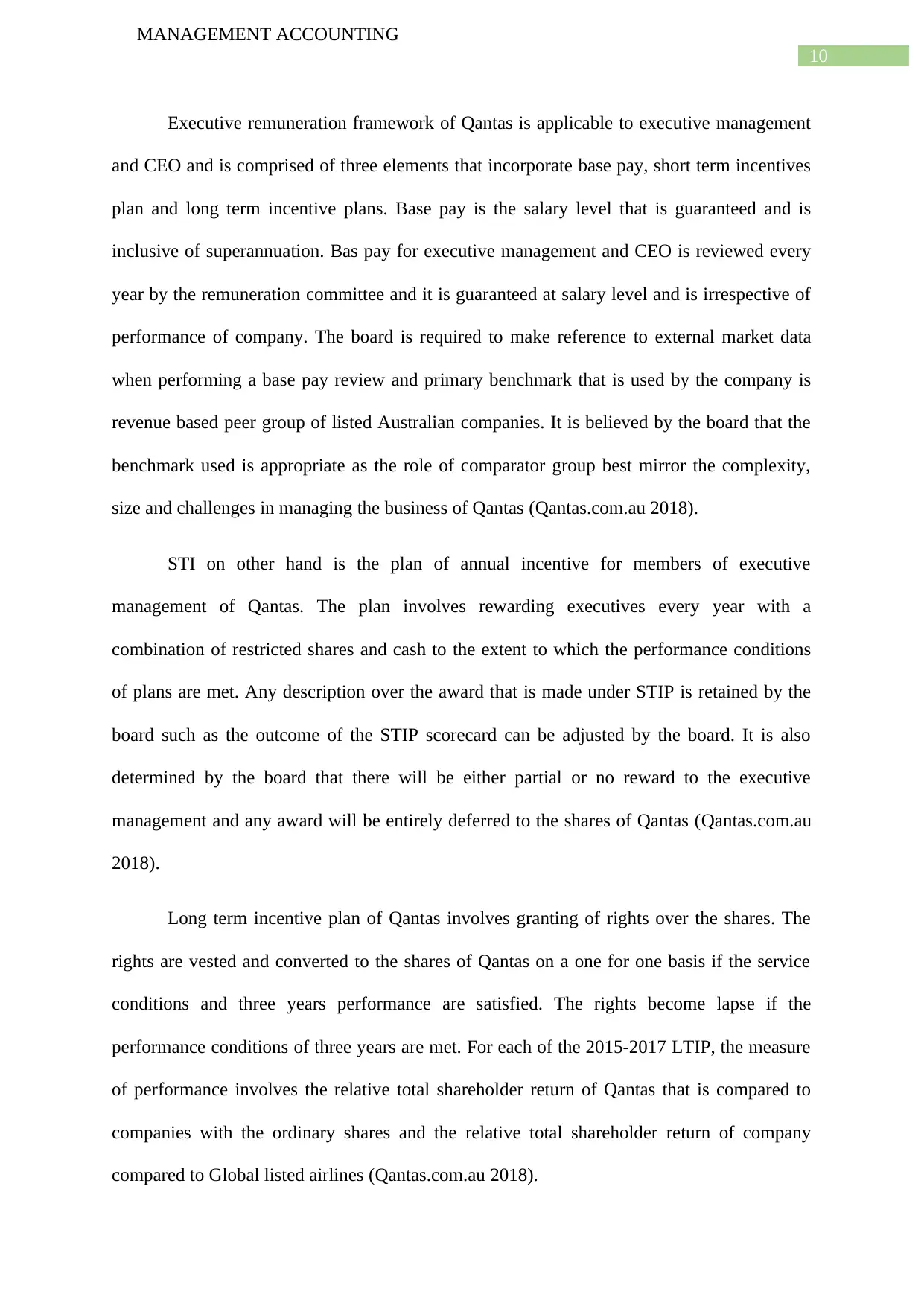
10
MANAGEMENT ACCOUNTING
Executive remuneration framework of Qantas is applicable to executive management
and CEO and is comprised of three elements that incorporate base pay, short term incentives
plan and long term incentive plans. Base pay is the salary level that is guaranteed and is
inclusive of superannuation. Bas pay for executive management and CEO is reviewed every
year by the remuneration committee and it is guaranteed at salary level and is irrespective of
performance of company. The board is required to make reference to external market data
when performing a base pay review and primary benchmark that is used by the company is
revenue based peer group of listed Australian companies. It is believed by the board that the
benchmark used is appropriate as the role of comparator group best mirror the complexity,
size and challenges in managing the business of Qantas (Qantas.com.au 2018).
STI on other hand is the plan of annual incentive for members of executive
management of Qantas. The plan involves rewarding executives every year with a
combination of restricted shares and cash to the extent to which the performance conditions
of plans are met. Any description over the award that is made under STIP is retained by the
board such as the outcome of the STIP scorecard can be adjusted by the board. It is also
determined by the board that there will be either partial or no reward to the executive
management and any award will be entirely deferred to the shares of Qantas (Qantas.com.au
2018).
Long term incentive plan of Qantas involves granting of rights over the shares. The
rights are vested and converted to the shares of Qantas on a one for one basis if the service
conditions and three years performance are satisfied. The rights become lapse if the
performance conditions of three years are met. For each of the 2015-2017 LTIP, the measure
of performance involves the relative total shareholder return of Qantas that is compared to
companies with the ordinary shares and the relative total shareholder return of company
compared to Global listed airlines (Qantas.com.au 2018).
MANAGEMENT ACCOUNTING
Executive remuneration framework of Qantas is applicable to executive management
and CEO and is comprised of three elements that incorporate base pay, short term incentives
plan and long term incentive plans. Base pay is the salary level that is guaranteed and is
inclusive of superannuation. Bas pay for executive management and CEO is reviewed every
year by the remuneration committee and it is guaranteed at salary level and is irrespective of
performance of company. The board is required to make reference to external market data
when performing a base pay review and primary benchmark that is used by the company is
revenue based peer group of listed Australian companies. It is believed by the board that the
benchmark used is appropriate as the role of comparator group best mirror the complexity,
size and challenges in managing the business of Qantas (Qantas.com.au 2018).
STI on other hand is the plan of annual incentive for members of executive
management of Qantas. The plan involves rewarding executives every year with a
combination of restricted shares and cash to the extent to which the performance conditions
of plans are met. Any description over the award that is made under STIP is retained by the
board such as the outcome of the STIP scorecard can be adjusted by the board. It is also
determined by the board that there will be either partial or no reward to the executive
management and any award will be entirely deferred to the shares of Qantas (Qantas.com.au
2018).
Long term incentive plan of Qantas involves granting of rights over the shares. The
rights are vested and converted to the shares of Qantas on a one for one basis if the service
conditions and three years performance are satisfied. The rights become lapse if the
performance conditions of three years are met. For each of the 2015-2017 LTIP, the measure
of performance involves the relative total shareholder return of Qantas that is compared to
companies with the ordinary shares and the relative total shareholder return of company
compared to Global listed airlines (Qantas.com.au 2018).
Paraphrase This Document
Need a fresh take? Get an instant paraphrase of this document with our AI Paraphraser
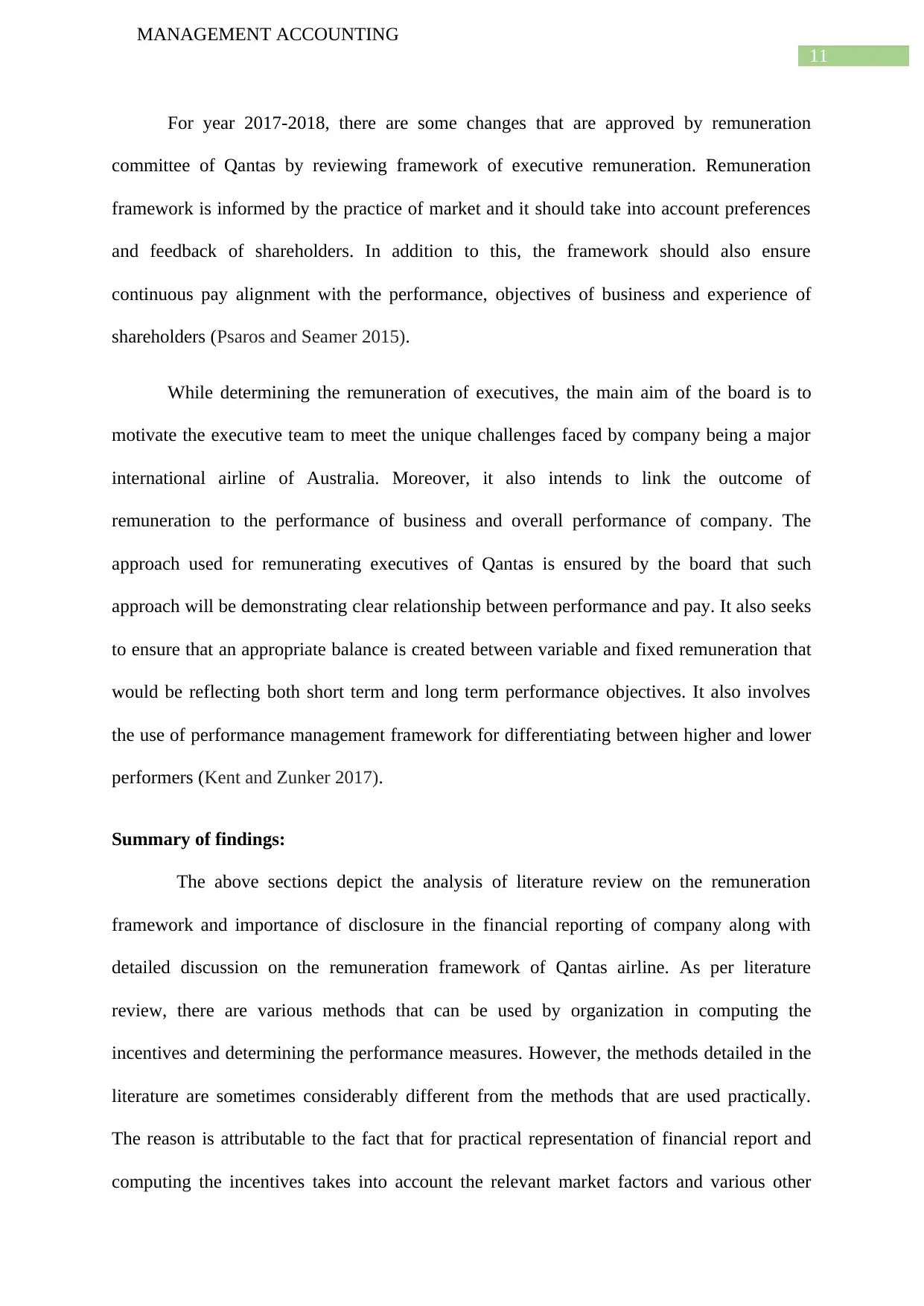
11
MANAGEMENT ACCOUNTING
For year 2017-2018, there are some changes that are approved by remuneration
committee of Qantas by reviewing framework of executive remuneration. Remuneration
framework is informed by the practice of market and it should take into account preferences
and feedback of shareholders. In addition to this, the framework should also ensure
continuous pay alignment with the performance, objectives of business and experience of
shareholders (Psaros and Seamer 2015).
While determining the remuneration of executives, the main aim of the board is to
motivate the executive team to meet the unique challenges faced by company being a major
international airline of Australia. Moreover, it also intends to link the outcome of
remuneration to the performance of business and overall performance of company. The
approach used for remunerating executives of Qantas is ensured by the board that such
approach will be demonstrating clear relationship between performance and pay. It also seeks
to ensure that an appropriate balance is created between variable and fixed remuneration that
would be reflecting both short term and long term performance objectives. It also involves
the use of performance management framework for differentiating between higher and lower
performers (Kent and Zunker 2017).
Summary of findings:
The above sections depict the analysis of literature review on the remuneration
framework and importance of disclosure in the financial reporting of company along with
detailed discussion on the remuneration framework of Qantas airline. As per literature
review, there are various methods that can be used by organization in computing the
incentives and determining the performance measures. However, the methods detailed in the
literature are sometimes considerably different from the methods that are used practically.
The reason is attributable to the fact that for practical representation of financial report and
computing the incentives takes into account the relevant market factors and various other
MANAGEMENT ACCOUNTING
For year 2017-2018, there are some changes that are approved by remuneration
committee of Qantas by reviewing framework of executive remuneration. Remuneration
framework is informed by the practice of market and it should take into account preferences
and feedback of shareholders. In addition to this, the framework should also ensure
continuous pay alignment with the performance, objectives of business and experience of
shareholders (Psaros and Seamer 2015).
While determining the remuneration of executives, the main aim of the board is to
motivate the executive team to meet the unique challenges faced by company being a major
international airline of Australia. Moreover, it also intends to link the outcome of
remuneration to the performance of business and overall performance of company. The
approach used for remunerating executives of Qantas is ensured by the board that such
approach will be demonstrating clear relationship between performance and pay. It also seeks
to ensure that an appropriate balance is created between variable and fixed remuneration that
would be reflecting both short term and long term performance objectives. It also involves
the use of performance management framework for differentiating between higher and lower
performers (Kent and Zunker 2017).
Summary of findings:
The above sections depict the analysis of literature review on the remuneration
framework and importance of disclosure in the financial reporting of company along with
detailed discussion on the remuneration framework of Qantas airline. As per literature
review, there are various methods that can be used by organization in computing the
incentives and determining the performance measures. However, the methods detailed in the
literature are sometimes considerably different from the methods that are used practically.
The reason is attributable to the fact that for practical representation of financial report and
computing the incentives takes into account the relevant market factors and various other
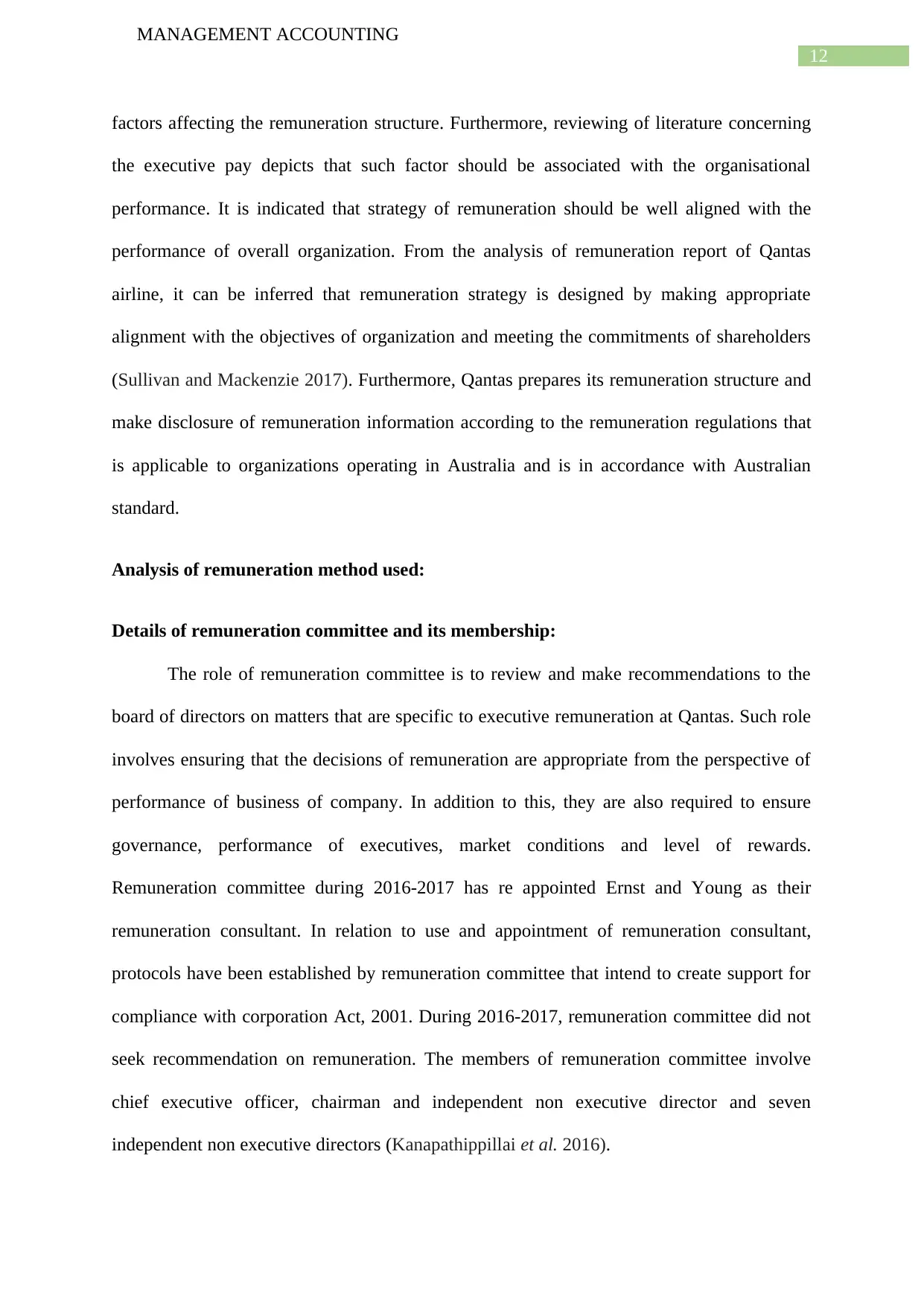
12
MANAGEMENT ACCOUNTING
factors affecting the remuneration structure. Furthermore, reviewing of literature concerning
the executive pay depicts that such factor should be associated with the organisational
performance. It is indicated that strategy of remuneration should be well aligned with the
performance of overall organization. From the analysis of remuneration report of Qantas
airline, it can be inferred that remuneration strategy is designed by making appropriate
alignment with the objectives of organization and meeting the commitments of shareholders
(Sullivan and Mackenzie 2017). Furthermore, Qantas prepares its remuneration structure and
make disclosure of remuneration information according to the remuneration regulations that
is applicable to organizations operating in Australia and is in accordance with Australian
standard.
Analysis of remuneration method used:
Details of remuneration committee and its membership:
The role of remuneration committee is to review and make recommendations to the
board of directors on matters that are specific to executive remuneration at Qantas. Such role
involves ensuring that the decisions of remuneration are appropriate from the perspective of
performance of business of company. In addition to this, they are also required to ensure
governance, performance of executives, market conditions and level of rewards.
Remuneration committee during 2016-2017 has re appointed Ernst and Young as their
remuneration consultant. In relation to use and appointment of remuneration consultant,
protocols have been established by remuneration committee that intend to create support for
compliance with corporation Act, 2001. During 2016-2017, remuneration committee did not
seek recommendation on remuneration. The members of remuneration committee involve
chief executive officer, chairman and independent non executive director and seven
independent non executive directors (Kanapathippillai et al. 2016).
MANAGEMENT ACCOUNTING
factors affecting the remuneration structure. Furthermore, reviewing of literature concerning
the executive pay depicts that such factor should be associated with the organisational
performance. It is indicated that strategy of remuneration should be well aligned with the
performance of overall organization. From the analysis of remuneration report of Qantas
airline, it can be inferred that remuneration strategy is designed by making appropriate
alignment with the objectives of organization and meeting the commitments of shareholders
(Sullivan and Mackenzie 2017). Furthermore, Qantas prepares its remuneration structure and
make disclosure of remuneration information according to the remuneration regulations that
is applicable to organizations operating in Australia and is in accordance with Australian
standard.
Analysis of remuneration method used:
Details of remuneration committee and its membership:
The role of remuneration committee is to review and make recommendations to the
board of directors on matters that are specific to executive remuneration at Qantas. Such role
involves ensuring that the decisions of remuneration are appropriate from the perspective of
performance of business of company. In addition to this, they are also required to ensure
governance, performance of executives, market conditions and level of rewards.
Remuneration committee during 2016-2017 has re appointed Ernst and Young as their
remuneration consultant. In relation to use and appointment of remuneration consultant,
protocols have been established by remuneration committee that intend to create support for
compliance with corporation Act, 2001. During 2016-2017, remuneration committee did not
seek recommendation on remuneration. The members of remuneration committee involve
chief executive officer, chairman and independent non executive director and seven
independent non executive directors (Kanapathippillai et al. 2016).
⊘ This is a preview!⊘
Do you want full access?
Subscribe today to unlock all pages.

Trusted by 1+ million students worldwide
1 out of 23
Related Documents
Your All-in-One AI-Powered Toolkit for Academic Success.
+13062052269
info@desklib.com
Available 24*7 on WhatsApp / Email
![[object Object]](/_next/static/media/star-bottom.7253800d.svg)
Unlock your academic potential
Copyright © 2020–2025 A2Z Services. All Rights Reserved. Developed and managed by ZUCOL.





